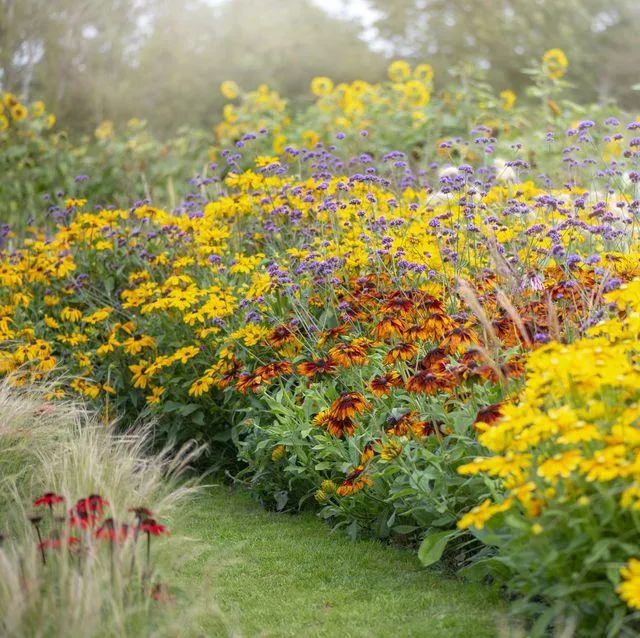A Guide to Beautiful Flowers You Can Grow Indoors
If you’re looking for fresh flowers to brighten up your home without a green thumb or outdoor space, fear not! There are many gorgeous blooms that thrive when grown indoors. From my experience as an avid gardener, these are some of the best options to consider.
Pothos
Pothos, or devil’s ivy, is one of the hardiest and easiest indoor plants to care for. Its heart-shaped leaves come in various bright and dark shades of green, making it a versatile accent for any room. Pothos flourishes with very little light or water—I’ve found it can go over a week between waterings! It’s practically impossible to kill. Use a clipping from an established pothos plant to propagate new vines for a fuller look. Place the cuttings in water and watch roots emerge within days.
Phalaenopsis Orchid
For gorgeous blooms without much fuss, phalaenopsis orchids are ideal. Commonly called moth orchids, they bear clusters of delicate white, pink, yellow or purple flowers. Water phalaenopsis about once per week by submerging the pot in a container of room temperature water for 10 minutes. The humidity loving orchid appreciates occasional misting as well. With proper care, phalaenopsis will flower repeatedly for months. Their glorious blooms make impressive gifts too.
African Violets
African violets bloom constantly when treated right, gifting you with colorful rosettes atop their green leaves. Place your violet in a spot with medium to low light. Use a well-draining potting mix and water only when the soil is dry an inch below the surface. Feed once a month to keep foliage healthy and flowers plentiful. You might be amazed by the diversity of colors and patterns in different African violet cultivars. Some have a lacy frill around their petals—major flower porn, if you ask me!
Chinese Evergreens
Chinese evergreens boast attractive variegated foliage in shades like pink, green, or cream splotched with white. Their decorative leaves persist year-round, making them a lush indoor addition. Give your Chinese evergreen bright, indirect light and keep soil lightly moist. I find they’re more tolerant of underwatering than overwatering. In warmer seasons, you may get small white flowers too. My Chinese evergreen has survived for years with minimal care—they’re super durable plants.
Snake Plants
Nicknamed “mother-in-law’s tongue,” snake plants are pretty much indestructible. Place one in a spot with very low to medium light. Allow the soil to dry out between waterings, going weeks without a drink if needed. Snake plants filter toxins from the air, making them ideal for home or office spaces. Their stiff, sword-like leaves come in solid colors or stripes of cream and green. Propagate new plants by dividing the rhizome. Snake plants are so hardy, even neglect won’t kill them—kind of like your carefree college roommate, amirite?

Peace Lilies
Peace lilies bear charming white blooms that arch gracefully above their shiny green leaves. Keep an eye out for flower spikes emerging from the center. Position yours in a spot with medium to bright indirect light. These drama queens will droop when soil becomes too dry, so water when the top inch is dry. They perk right back up after a good drink. Peace lilies thrive on high humidity too, so consider a pebble tray or occasional misting. Overall, they make a lovely addition to any home with their pure white blossoms.
Jasmine
For an intoxicating tropical scent indoors, nothing beats star jasmine. This climbingervine bears small white flowers that release an alluring fragrance, especially at night. Provide your jasmine a trellis or moss pole to climb. Place in a spot with bright, indirect light and keep soil lightly moist. Come spring, you’ll be showered in fragrance! Enjoy fresh bouquets by snipping stems for a vase too. Just be warned—once you experience jasmine’s perfume, you’ll be hopelessly hooked.
Other great indoor flowering options:
- Geraniums – Come in bright colors with a lovely rose scent
- Dieffenbachia – Tropical foliage plant bearing white flowers
- Angelonia – Masses of colorful blooms on compact plants
- Begonias – Cheery blooms in shades of pink, red and white
- Impatiens – Sun-loving plants bearing colorful hanging flowers
Care Tips for Your Indoor Blooms
While many flowering houseplants are forgiving, there are a few best practices that will help your indoor floral friends thrive:
Light
Most need medium to bright, indirect sunlight. West or east-facing windows provide ideal exposure. Rotate plants weekly so all sides receive light.
Water
Allow soil to partially dry between waterings. Check soil moisture by digging your finger an inch below surface. Water thoroughly but avoid soggy roots.
Humidity
Orchids and many others appreciate high humidity. Consider pebble trays, humidifiers or occasional misting. Too dry air causes leaf drop.

Fertilizer
Feed monthly in spring and summer with a diluted liquid houseplant formula. Applying fertilizer prompts strong new growth and repeat blooming.
Pruning
Deadhead spent flowers to encourage reblooming. Also trim leggy stems or remove any yellowed leaves to keep plants looking lush.
Pests
Check regularly for signs of aphids, spider mites or mealybugs. Address issues promptly before an infestation occurs.
Propagation
Many flowering plants can be propagated from stem or leaf cuttings for new plants. Give it a try—it’s rewarding to nurture new growth!
Patience and TLC
Indoor flowers may sulk temporarily from stress. With optimum care, they’ll soon perk back up good as new. Enjoy your blooms—they’re like nature indoors!
I hope this guide has answered your questions about growing cheerful flowers inside. Please feel free to ask if any part needs more clarification. With the right varieties and care, you can turn your home into an indoor garden paradise all year round. Happy planting!

Indoor Flowers: Types and Care Requirements
| Name | Light Needs | Watering | Bloom Period |
|---|---|---|---|
| Orchid | Medium | Allow soil to dry between waterings | Spring-Summer |
| Pothos | Low | Water when top inch of soil is dry | Spring-Fall |
| Peace Lily | Medium | Water when soil is dry | Spring-Fall |
| Chinese Evergreen | Medium-Low | Allow soil to partially dry between waterings | Spring-Fall |
| Snake Plant | Low | Water infrequently, allow soil to dry completely | Spring-Summer |
FAQ
-
What kinds of flowers can grow indoors?
There are quite a few different types of flowers that can basically survive inside your home. Popular choices include things like potted orchids, African violets, peace lilies, and Chinese evergreens. At the same time, roses and tulips and hyacinths will not do too well inside since they need more direct sun. But you can still have your pick of gorgeous blooms without a green thumb!
-
How do I care for indoor flowers?
Caring for flowers that live inside is pretty simple. You need to provide them with bright, indirect light. Maybe put them on a windowsill if possible. Water them whenever the soil becomes kinda dry. Don’t wanna overdo it and drown the roots! Also, you can fertilize them every few weeks during the growing season. Pay attention and they’ll reward you with beauty for months to come, perhaps bringing back fond memories of mum’s garden.
-
Which flowers need the most sunlight?
Certain kinds of flowers will absolutely want more sunlight to thrive than others. One that comes to mind is African violets. They sort of need partial shade, like from an east-facing window. Otherwise, their leaves might burn. Strong sunlight is best for blooms like daisies and roses and orchids. So put your sun lovers in a west or south window if you got it. Aim for at least six hours a day minimum. Too little light and you’ll only get foliage, no flowers.
-
What grows best in low light?
Some top choices for flowers that can handle low light conditions are pothos, snake plant, chinese evergreen, and bamboo palm. These beauties are awesome because they’re virtually impossible to kill – perfect for amateur gardeners! Peace lilies, philodendrons, and english ivy also do well in darker spots. You know, my grandma used to have a hanging basket of ivy that must have been like a hundred years old. It just never quit! Maybe i’ll try growing some myself as a fun throwback.
-
How do I water indoor flowers correctly?
Promoting healthy plant growth requires providing adequate hydration. Check the soil regularly and water when the top inch becomes dry. You don’t wanna overdo it though, or the roots can start rotting. For most potted flowers, watering every 5 to 7 days should hit the sweet spot. Alternatively, you can stick your finger in the soil and go by feel – moist but not soaked is the happy medium. And don’t forget to flush any dried up excess salts from previous waterings by running fresh water through until it drains out the bottom. Try it, you’ll get the hang of it in no time!
-
Can indoor flowers repel bugs?
You bet! Several flowers are famous for their natural insect-repelling properties. Surprise your pesky gnats or fruit flies by scattering some fresh basil, chives, garlic or lemon balm around the problem plants. Citronella geraniums and certain petunias also boast insects-be-gone abilities. But I wonder, is it like using a sledgehammer to crack a nut? If a few bugs show up, they’re probably not doing much harm. Might be better to just cozy up to our tiny six-legged amigos. What do you guys think – friend or foe? Either way, flowers sure can spruce up the home nicely even without any bug banishing powers.

-
What’s a good indoor blooming schedule?
By choosing a mix of flowering plants that bloom at different times, you can basically have color and fragrance around all year long. Make sure your collection includes those that bloom in spring, summer, fall and winter. Tulips and hyacinths dazzle in spring, followed by begonias, impatiens and gerbera daisies. Colors peak again come chrysanthemum and poinsettia season around the holidays. And don’t forget mini roses and amaryllis to shine through the dreariest months. With a bit of planning like this, your indoor bouquet will have you oohing and ahing all twelve months through.
